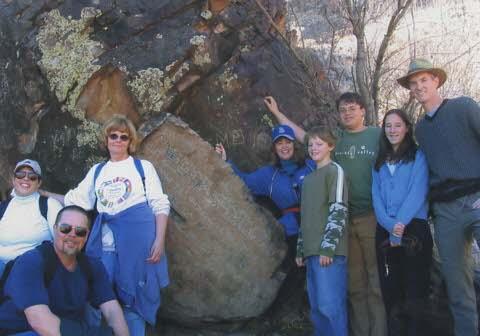The Phoenician Rock lies at the base of Mystery Mesa, sometimes called Hidden Mesa, in a remote area controlled by the BLM. It is west of Los Lunas and about 35 miles southwest of Albuquerque. A BLM permit is required to enter the area.
The stone is covered with what experts have called Paleo-Hebrew script, which is practically identical to the Phoenician script. Also included, according to some experts, are Samaritan and Greek letters. Some have argued that the stone uses modern Hebrew punctuation, indicating that it is a modern creation. Other researchers point out stylistic and grammatical errors to question its authenticity.
What it says depends on who translates it. Some ethnographers have suggested that the text is an early version of the Ten Commandments. Others say that it tells the story of a Phoenician sailor, lost at sea, who yearns to return home.
The writing is set at an angle, suggesting that it shifted or fell from its original position.
The first time the stone is mentioned in historical records is in 1933, when University of New Mexico archaeology professor Frank Hibben clains to have been led to it by an unnamed and uncredited Indian guide. Hibben writes that his guide claimed to have found it as a boy in the 1880s. After Hibben announced his discovery, a Los Lunas man named Florencio Chavez announced that his grandfather claimed to have seen the rock in 1800.
I've been to the rock several times, and while I am no expert on ancient texts, I find the rock interesting. Of more interest to me, though, are the Indian pictographs and ruins on the top of the mesa. This site was an outlier community that linked Acoma Pueblo to the west with the Rio Grande and the trading communities that strung along that ribbon of water, tying the arid southwest to the Mayan Civilizations to the south and the nomadic plains tribes to the northeast.
What those Indians thought of the strangely marked rock - if it was indeed there when they were - if a real mystery.


